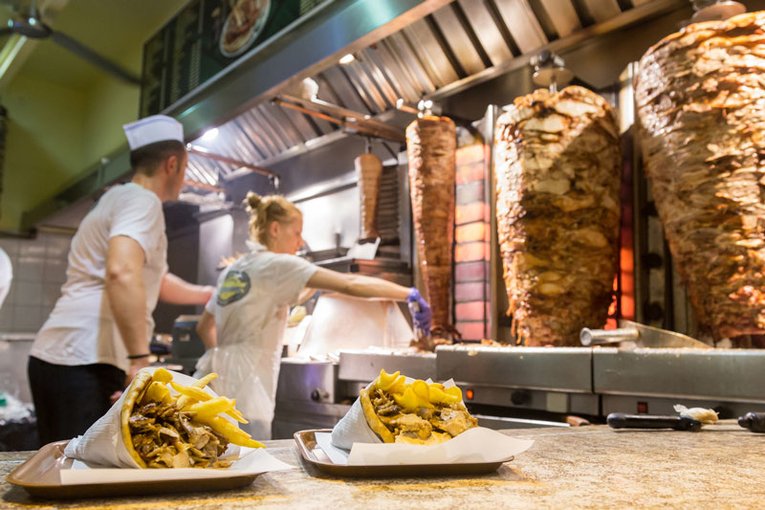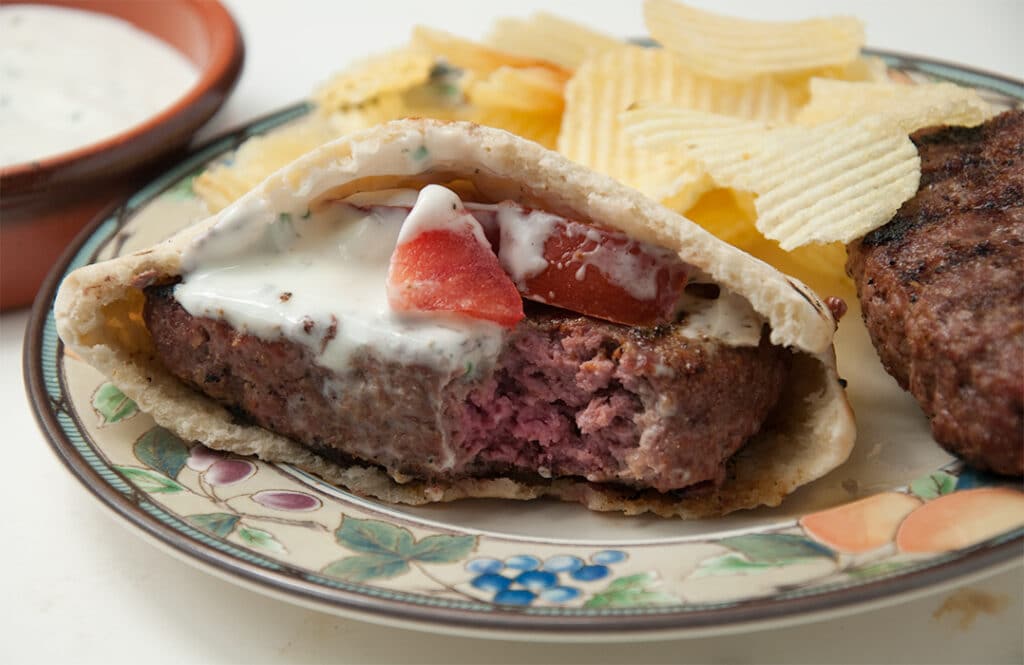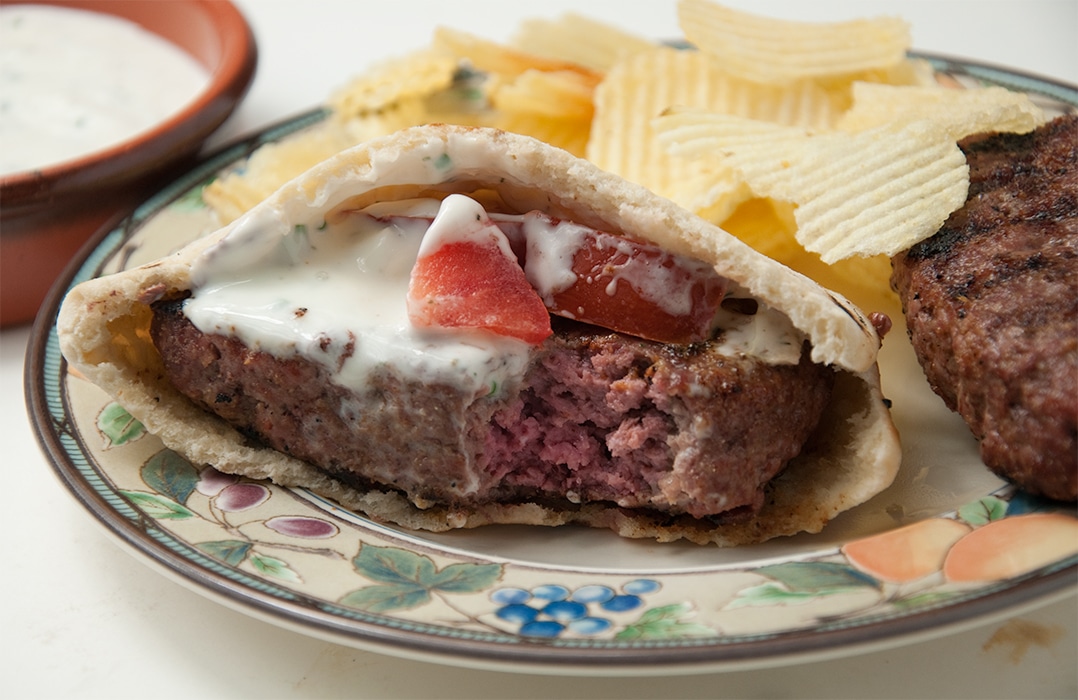Up your burger game with these mouthwatering lamb burgers with tzatziki sauce.
Making real gyros at home is tricky, but you can come close. Restaurant gyros in the US is usually made from ground lamb, often blended with beef and pork, heavily and heavenly compressed into a giant cone. In Greece, it is not uncommon to find it made from whole slabs of chicken or pork stacked on a spear very much like Mexican Al Pastor.
The cone of meat is speared with a rotisserie and stood vertically in front of a glowing infrared burner. As it rotates, the exterior browns, and when you place your order the cook slices off a thin shaving of the crunchy brown outside layer. The meat is then served on a pita flatbread and usually dressed with chopped tomatoes, shredded iceberg lettuce, sliced red onions, cucumber, and tzatziki sauce made from yogurt, mint, cucumbers, and garlic.
The concept of the vertical rotisserie browning the outside layer, shaving it off, and browning the inside layer, is used for doner kebabs, shawarma, and tacos al pastor. Below is a picture of a typical gyros setup from Kronos, a company that makes Gyros.

The challenge is making the meat cone, which usually consists of 10 to 40 pounds of meat, plus the vertical rotisserie. I’ve tried to make it work on a horizontal rotisserie, and the meat just sags and falls off. But you can come close by making a patty and grilling it crispy on both sides, and you can even leave it pink in the center. When cooked properly, I like lamb burgers better than beef burgers! Next time you have a burger jones, make it a lamb burger. Most groceries carry ground lamb. Often in preformed patties. Preparing these burgers is a snap and you might not go back to beef burgers.
Making the burgers couldn’t be simpler. The sauce is the key. I know you want to put ketchup on your burgers, but lamb has been a staple of the Greek diet for centuries, and it really does taste best with tzatziki. The sauce below, developed by my wife, is not traditional tzatziki, but it’s close, and I like it better. You’ll be surprised at how well it works on lamb burgers. We serve them with a big green salad and use the sauce as a salad dressing too. I’ve even been known to pack the salad into a pita and eat it that way.
Makes:
Takes:
Ingredients
- 1 1/2 pounds ground lamb
- 1 tablespoon vegetable oil
- 1 teaspoon Morton Coarse Kosher Salt
- 1/2 teaspoon ground black pepper
- 1/2 teaspoon garlic powder
- 4 pita pockets
- Tzatziki yogurt sauce
- 2 medium tomatoes, chopped
- 1/2 cup shredded lettuce
- 1 small red onion
These recipes were created in US Customary measurements and the conversion to metric is being done by calculations. They should be accurate, but it is possible there could be an error. If you find one, please let us know in the comments at the bottom of the page
Method
- Prep. Prepare the tzatziki yogurt sauce according to the recipe found here. You can do this the night before and that will help pull flavor out of the herbs. Also thinly slice the onion.
- Fire up. Prepare your grill for hot direct heat. If your gas grill has a sear burner or infrared burner, this is what it is for. The burgers can also be cooked easily on a hibachi.
- Prep again. Form the meat into patties about 4 to 6 ounces (112 to 168 g) each, 1/4 to 1/2" (6.3 mm to 13 mm) thick and shaped like a football so they will fit neatly into pita halves. Coat them with the oil, and then with the spices. That may seem like a lot of spices, but we want to form a nice crust.
- Cook. Put the burgers on the grill, close the lid, and stand there. Sing Mary Had a Little Lamb four times or about four minutes, then check the underside. You want it dark, but not black. Cook the burger until it hits a safe temp of 160°F (71°C). Toss the pitas on the grill for 30 to 60 seconds on each side, enough to warm them.
- Serve. Serve the burgers by cutting the pitas in half. Press the sides gently to pop open the pocket. Spoon about a tablespoon of sauce in, put some chopped tomato, lettuce, and onion in, squeeze the burger in on top, and slather more sauce on the burger. Make sure everyone has plenty of napkins.




High quality websites are expensive to run. If you help us, we’ll pay you back bigtime with an ad-free experience and a lot of freebies!
Millions come to AmazingRibs.com every month for high quality tested recipes, tips on technique, science, mythbusting, product reviews, and inspiration. But it is expensive to run a website with more than 2,000 pages and we don’t have a big corporate partner to subsidize us.
Our most important source of sustenance is people who join our Pitmaster Club. But please don’t think of it as a donation. Members get MANY great benefits. We block all third-party ads, we give members free ebooks, magazines, interviews, webinars, more recipes, a monthly sweepstakes with prizes worth up to $2,000, discounts on products, and best of all a community of like-minded cooks free of flame wars. Click below to see all the benefits, take a free 30 day trial, and help keep this site alive.
Post comments and questions below
1) Please try the search box at the top of every page before you ask for help.
2) Try to post your question to the appropriate page.
3) Tell us everything we need to know to help such as the type of cooker and thermometer. Dial thermometers are often off by as much as 50°F so if you are not using a good digital thermometer we probably can’t help you with time and temp questions. Please read this article about thermometers.
4) If you are a member of the Pitmaster Club, your comments login is probably different.
5) Posts with links in them may not appear immediately.
Moderators